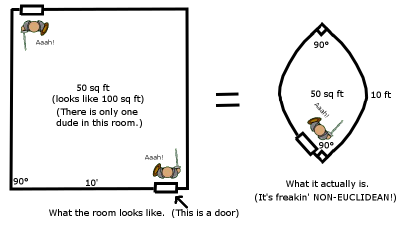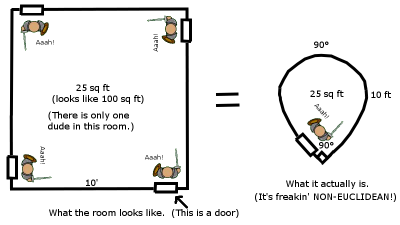Non-Euclidean Architecture: Part 2
In which more methods are expounded by which one may refine a dungeon to more sublime levels of confusion.
This isn't nonsense--this is logic!
This is a sequel to my first essay on non-Euclidean architecture. If you haven't read that one first, you should.
Non-euclidean spaces just mean that parallel lines don't stay the same distance apart. They either bend together or splay apart. Four right angles don't always make a square.Â
A lot of the ideas below are not technically non-Euclidean, but they're close enough. They all play around with illogical spaces and angles in a way to make an environment illogical.
Hyper-elliptic Spaces: How to Stab Yourself in the Face
Let's go back to the pillar room from the last article. Remember the instance where the room only had 3 square corners before you walked back to where you started? The walls are all 10' long, but the room is only 75 square feet. That's a hyper-elliptic space.
But what if it got even more elliptic? What if the room had only two walls with 90 degree corners? You walk along one wall, turn squarely to your left, and face the wall back to the corner where you started. Maybe a picture will help.

I got rid of the pillar, because we are now wise to the ways of Cthuhlu and don't need that silly mental crutch anymore. Mental aids are for larva who haven't even had their first brainfeasting. Anywway, what if we cranked up the curvature of space even more? What if the 'square' room had only one wall, and one corner?

Hopefully, your players will think that they are dealing with dopplegangers or mimics or something and will attack themselves. It's totally possible for a rogue to run up to the center and sneak attack himself in the back. If you are lucky, the wizard will decide to nuke all these impostors and will get hit by his own fireball four times (think of it as the explosion curving back in on itself, so that it hits many places from many directions, not just one).
You can crank up a hyper-elliptic room to higher levels of awesome if you want. Why not have a 170 degree corner behind you, and 100 copies of yourself? If you run a few laps you'll finally get to see what your butt looks like when you run. Also good for dressing rooms!  And giving yourself a solo massage!
Tactically, combat is pretty similar, although you have a nice, wrap-around arena to do it in. If you want to ignore all the rules of logic, use the square room from the first image, drop down two miniatures for each character in their rotationally opposed positions, and then drop in a few monsters that ignore this mirroring. I'd never run a combat like this because its chess-like and (doubly) paradoxical, but if this is your cup of tea, by all means, drink it.
3-Manifolds and Beyond: How to Explode Brains
A key concept in dealing with non-euclidean spaces is that they are locally normal but globally weird. One example of this concept is a manifold which is (sorry in advance for butchering this concept, math majors) a space that looks three dimensional when you zoom in, but is actually four dimensional when you zoom out.
An example of a 2-manifold would be the surface of a balloon. Circles have been drawn on the surface of this balloon, and little two-dimensional creatures live on the circumferences of these circles. Now pretend that these circles are planets. The little creatures take off in their spaceship to find the center of the universe, but eventually just come back to where they started. Why did a straight line take them back to where they started? Because they are 2D critters living on the surface of a 3D sphere, and their tiny brains can't grasp this. Where is the center of the universe? There is none, but the universe can still expand and contract because it's a balloon (and explode?) We are 3-dimensional creatures living in a 4-dimensional universe (a 3-manifold) trying to understand it with brains that evolved to hunt mammoths, so it's natural that things are going to get confusing when we think about bent space time.
I'm rambling.Â
Sorry.
Let me try again.
3-Manifolds and Beyond: How to Explode Brains
Basically, any type of warped dungeon you can imagine can be accommodated by some type of non-euclidean space. But let's start small.
Imagine if you drew a dungeon on the surface of a six-sided die. Each side of the die is a different room. You have six rooms, and each room has four doors. However, there is no outer wall to this dungeon. And if you try to find an exit by following one of the walls, you'll only come back to where you started-and you'll only see 3 rooms out of the six. You'll also make three right turns to get there. This is a simple example of a 3-manifold.
You could draw a dungeon on the surface of any of your dice. Or you could draw it on the surface of a donut, a.k.a. a torus. If you've played the old arcade game Asteroids, you are already familiar with a toric surface. If you run off the left side of the screen, you enter on the right side. If you fly off the top of the screen, you reappear from the south.
If you're feeling adventurous, make a dungeon on the surface of a tessuract, a four-dimensional cube. It's a lot like the 'surface of a six-sided die' thing, except that every room has six doors: one in each wall, one in the floor, and one in the ceiling. Tessuracts have actually been used as dungeons before-Dragon magazine published a how-to guide, and you can find other guides online. The tricky thing is that gravity gets scrambled pretty quickly, along with any notion of a 'north'.Â
Wrap-around dungeons like this are awesome, but they might just annoy the players who are trying to draw a decent map unless you have a lot of non-Euclidean stuff in this spaceship/arcology/R'lyeh to really make the theme clear.
If you want to mess around with gravity/elevation, you could also design a dungeon around more ridiculous stuff, such as M.C. Escher's waterfall painting.
Speaking of water. . .
Multi-Directional Gravity: How to Fall Forever Without Leaving the Room
Gravity only points in one direction at any given location. But what if it didn't? What if gravity pointed one way on the north side of a room and a slightly different direction on the other?
There are three basic ways you can muck with gravity inside a room. If gravity changed its angle slightly as you went around the room, you could have a room where (a) everything slides away from the center of the room, (b) everything slides towards from the center, and (c) everything slides around and around.
Option (a) lets you turn a flat room into a mountain. The best part is that it looks flat until you step into it-then your inner ear adjusts and you feel like you are standing on a hillside. Option (b) lets you turn rooms into valleys (or just put a weird mound of water in the center of it--a puddle!) And option (c) lets you create perpetual motion machines if you fill the room with a few round rocks, a foot of water, or bumbling adventurers.
This isn't really anything non-euclidean (it's gravity- or light-bending) but whatever.
Fighting Non-Euclidean Creatures: How? Â Seriously, How?
You sort of can't. They just don't map well to a three dimensional world.
The best I can come up with is to use the Pillar Room, and use some sort of boss as the pillar. Maybe it has 20 heads, and you have to run a few laps around the room before you can see all the heads. Maybe it's a mountain of thrashing tentacles and horrible, nameless orifices.  Maybe you are doing the six-sided die thing, and the monster takes up the entirety of one of the rooms, which means that the boss is actually four walls on opposite sides of the dungeon (the sixth room).
Alternatively, you can invoke the themes of non-Euclidean spaces by imitating some of their weirder aspects. Enemies might spin their head around to reveal that it has more faces than should be possible. It might vomit up creatures that are bigger than it. It might seem to teleport, or shunt itself somewhere else. Lovecraft has the Hounds of Tindalos emerging from anyplace where sharp angles meet. You could make a creature that has no distinction between the inside and outside (we're already inside of it, in a way).  If you want to start using insanity rules, this is a good place to start.
Closing Remarks
That's it. That's all I got.
If you want to insert of bit of non-intuitive logic into your game, or just inject it with some insanity, I hope this guide helps somewhat.
Iä! Iä! Cthulhu Fhtagn!
Special thanks to Dozus for reminding me to write the rest of this.
Not Registered Yet? No problem.
Do you want Strolenati super powers? Registering. That's how you get super powers! These are just a couple powers you receive with more to come as you participate.
- Upvote and give XP to encourage useful comments.
- Work on submissions in private or flag them for assistance.
- Earn XP and gain levels that give you more site abilities (super powers).
- You should register. All your friends are doing it!
? Responses (12)
*brain oozes out of ear*
But Mmm-mm good!! I mean i need these 2 primers with me at all times.
I'm not smart enough to come up with points of contention. Groovy!!
Very nice! It does boggle the mind, but you explain it well enough to encourage usage.
Bonus points to someone who effectively creates a non-euclidian monster for a campaign.
This sounds like a good way to destroy the sanity of characters and players alike (maybe GM too). I especially appreciate the visual aides.
I love it and I heartily thank you for it
Very nicely done - great use of images!
I love these two subs. Both are well-written, and make a very difficult subject (that we all seem to love the concept of) accessible and usable to average GMs. I love that you include lots of solid examples of ways that these concepts can be used.
Very nicely done.
Not much to add, here. Possibly more usable than the first part of this series -- I enjoyed the pictures and examples. Playing with gravity would be quite fun, too. Imagine walking across a room and suddenly falling towards the right wall!
Thank you for this. I'm getting more than a little mileage from this on my Pumpkin Scat Quest.
A worthy addition/completion of Part 1. I really have nothing more to say, so, good work!
I was waiting for this! Probably the best part (to me anyway) was the talk about manifolds. The difference between global and local properties is a very important topic in topology, and you can come up with some pretty crazy stuff. I'm tempted to create a dungeon that is a double torus or a Klein bottle or such, simply because of this submission. Bravo, very well done.
Great job. Take a HoH. And a hyper-elliptic award room (double the trophies! Impress your guests!)
I did come up with a way to make a non-euclidean battle map, specifically a hyperbolic one (the concept should also work with an elliptical one, but I haven't actually made that one yet). The trick was to CROCHET the battle map. A quick Google of "non-euclidean crochet" will show what I mean, but it's actually really easy to make hyperbolic surfaces with crochet. Some university physics departments actually use crochet specifically to model non-euclidean surfaces for exactly this reason. So I figured out the general pattern I wanted for the surface and crocheted it as a non-euclidean surface, including crocheting in an (approximately) 1" grid on the surface. When battle begins, I can flatten out a local area of the map where players are located, but everything else is scrunched and overlapping.
